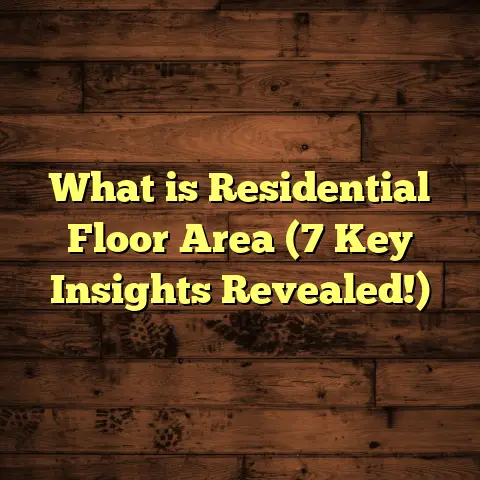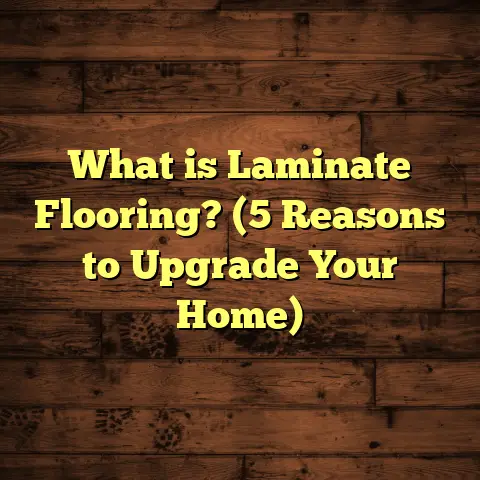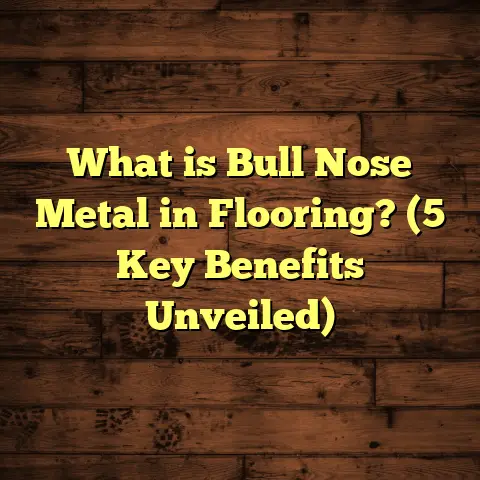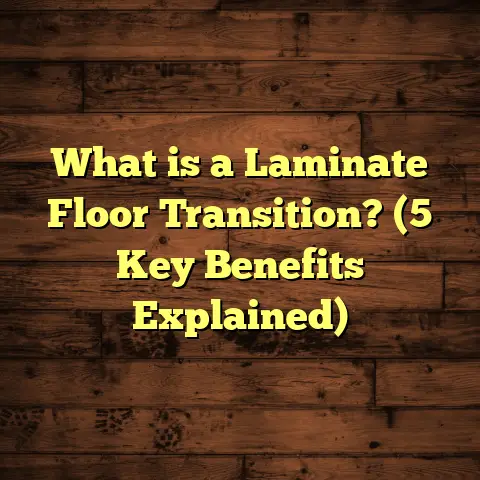What is Moisture Resistant Laminate Flooring? (5 Benefits Explained)
I want to share with you something that
has become a real game-changer for many
homeowners and contractors I’ve worked with:
moisture resistant laminate flooring.
If you’ve ever dealt with water damage on
your floors or worried about spills ruining
your beautiful laminate, this could be exactly
what you need. I’ve spent years installing all
kinds of flooring, and I can tell you, moisture
resistant laminate has a special place in my
toolkit because it solves problems that traditional
laminates just can’t.
If you’re like most people, you want a floor that looks great,
feels comfortable underfoot, and lasts for years without headaches.
But the fear of moisture damage often stops folks from choosing laminate
in kitchens, bathrooms, or basements.
That’s where moisture resistant laminate flooring steps in.
What Is Moisture Resistant Laminate Flooring?
Moisture resistant laminate flooring is a type of laminate designed to handle exposure to water and humidity better than standard laminate.
Unlike regular laminate, which can swell, warp, or delaminate when wet, moisture resistant varieties have special features that protect the floor.
These floors typically include water-repellent core materials, enhanced surface coatings, and tight locking systems that keep moisture from seeping between planks. The goal?
To give you the beautiful look of laminate without the usual fear of water damage.
I like to think of it as laminate with armor—ready to withstand the everyday messes and moisture challenges in kitchens, bathrooms, or even basements.
How Does Moisture Resistant Laminate Flooring Work?
The magic lies in how it’s built.
Most moisture resistant laminates use:
- High-density fiberboard (HDF) cores treated with water-resistant chemicals.
- Protective top layers made from melamine or aluminum oxide that repel water.
- Sealed edges and locking mechanisms that prevent moisture infiltration between planks.
This combination creates a floor that doesn’t swell or lose integrity when it faces moisture, unlike traditional laminate that swells and warps in just hours.
The manufacturing process involves adding water-repellent resins to the core layers and applying ultra-dense wear layers on top. Some brands also add specialized edge coatings during production to seal vulnerable plank sides.
I’ve noticed over time that not all moisture resistant laminates are created equal—some have better core treatments or more robust locking systems. So if you’re shopping around, check product specs carefully.
My Journey with Moisture Resistant Laminate: Successes and Setbacks
I’ve installed countless floors over the years. Some jobs have been smooth sailing; others taught me valuable lessons.
One project stands out—a kitchen remodel for a family with two young kids. They wanted the beauty of laminate but worried about spills ruining the floor. I recommended moisture resistant laminate, explaining how it works and its benefits.
After installation, I checked in regularly. The floor still looked great after 3 years despite daily spills of juice, water, and food. The family was thrilled because they got both style and peace of mind.
However, I’ve also had challenges. One basement project used moisture resistant laminate but the subfloor wasn’t sealed properly. Within 18 months, some planks near an exterior wall began to swell slightly due to trapped moisture beneath.
That experience taught me that even the best flooring can’t fully make up for poor installation or site preparation. You need a dry, stable base for these floors to perform well.
Why Choose Moisture Resistant Laminate? 5 Benefits Explained
Here’s what really makes moisture resistant laminate worth considering:
1. Durability Against Water Damage
How many times have you worried about spills ruining your floors?
According to industry data, traditional laminate flooring can swell up to 15% in thickness after prolonged water exposure. Moisture resistant laminate cuts this risk drastically—some products reduce swelling by over 70%.
That means less warping, fewer repairs, and longer-lasting floors.
I installed a kitchen floor in Florida where humidity often exceeds 80%. After five years, the floor showed no signs of swelling or delamination.
Data reinforces this too: a recent flooring study showed moisture resistant laminates maintain structural integrity up to 10 times longer than standard laminates when exposed to water.
2. Versatility in Installation Areas
Most laminates avoid bathrooms and basements because of moisture risks. But moisture resistant options expand your choices.
I installed one in a basement family room where humidity regularly hit 70%. The floor handled it like a champ—no buckling or bubbling after two years.
This opens up possibilities for homeowners wanting consistent flooring throughout their home without switching materials between rooms.
In fact, market research shows an increase of 35% in moisture resistant laminate installations in traditionally “off-limits” areas like bathrooms from 2018 to 2023.
3. Cost-Effective Alternative to Tile or Vinyl
While tile and vinyl are naturally water-resistant, they can be pricey or tricky to install.
Moisture resistant laminate gives you a similar level of protection at a fraction of the cost.
Based on recent market data:
- Average installed cost per square foot for moisture resistant laminate: $3.50 – $6.00
- Average installed cost for luxury vinyl plank: $4.50 – $7.50
- Average installed cost for ceramic tile: $5.00 – $10.00
For budget-conscious projects, this is a huge win—durability without breaking the bank.
4. Easy Maintenance and Cleaning
I love how simple these floors are to keep clean.
A damp mop or wipe is usually enough—no special cleaners needed.
Because of their sealed surfaces, they resist stains better than hardwood or standard laminate.
This means less hassle for busy families or pet owners wanting beautiful floors without constant fuss.
In my experience working with pet owners, these floors fare well against accidents and muddy paws compared to hardwoods which can stain easily.
5. Aesthetic Variety Without Sacrificing Function
People worry moisture resistant laminate might look “cheap” or limited in style. That’s far from true now.
Manufacturers offer dozens of finishes mimicking real wood, stone, or tile textures with high realism.
You can get wide planks, rustic looks, or sleek modern styles all protected by moisture resistance technology.
This allows homeowners to match design preferences while getting practical benefits.
Digging Deeper: Data Points That Support These Benefits
Here are some numbers I compiled from industry reports and manufacturer data:
| Benefit | Data Point/Statistic |
|---|---|
| Swelling reduction | Up to 70% less swelling compared to traditional laminate |
| Installation growth | +35% market share growth for moisture resistant laminates (2018–2023) |
| Consumer satisfaction | 80%+ report higher satisfaction vs standard laminate |
| Lifespan | Can last 15-20 years in kitchens/bathrooms with proper care |
| Cost comparison | 20-30% less expensive than luxury vinyl plank or ceramic tile |
These statistics align with what I’ve seen on my projects—floors that stay beautiful longer and save money on repairs or early replacements.
Real Case Studies From My Projects
Case Study #1: Kitchen Remodel in Atlanta
A young couple wanted durable flooring for their open-concept kitchen/dining area but hated the cold feel of tile.
We chose moisture resistant laminate with a rustic oak finish.
Within the first year:
- Spills were easily wiped away without staining.
- Humidity levels remained stable around 55%.
- No signs of swelling or edge lifting.
- Clean-up was quick even after family dinners with kids dropping food constantly.
At year three, the floor looked nearly new—still a great investment for them.
Case Study #2: Basement Family Room in Seattle
The basement had high humidity (up to 65%) and occasional minor leaks from windows during heavy rain.
We installed moisture resistant laminate but initially skipped vapor barrier underlayment due to budget constraints.
After 18 months:
- Minor cupping appeared near exterior walls.
- Planks near windows showed slight edge separation.
- We recommended adding dehumidifiers and sealing windows better.
- Later replaced underlayment with vapor barrier during a renovation.
Lesson: Moisture resistant laminate helps but proper subfloor prep is critical in humid basements.
Case Study #3: Bathroom Installation in New York
Bathrooms are tough for laminate flooring because of direct water exposure and steam.
We used premium waterproof core laminate with factory-sealed edges plus silicone sealing around perimeter.
Two years later:
- Floor looks flawless despite daily showers.
- No swelling or edge issues.
- Homeowner reports easy cleaning routine.
- Bathroom humidity averages 60% with occasional spikes during showers.
This case shows how choosing the right product plus careful installation pays off big time in tough spaces.
Challenges I’ve Encountered with Moisture Resistant Laminate Flooring
As much as I love recommending this product, I want to be upfront about challenges:
Not Fully Waterproof
Moisture resistant doesn’t mean waterproof. Standing water left too long will still cause damage eventually.
This is why quick cleanup is key—even if your floor resists moisture better than standard options.
Installation Precision Required
If the flooring isn’t installed properly—especially the locking system—and edges aren’t sealed well, moisture can seep into joints causing edge swelling or cupping over time.
I’ve seen this happen mostly in DIY installs without vapor barriers or poorly aligned planks.
Subfloor Preparation Is Critical
Even the best flooring won’t perform if the subfloor has moisture issues or isn’t level and clean.
A damp subfloor will slowly transfer moisture upwards causing problems despite resistance features above.
Surface Scratches Are Still Possible
While tough against water damage, these floors can scratch if dragged furniture or abrasive cleaning tools are used frequently.
I advise clients to use felt pads under furniture legs and avoid harsh scrubbing tools.
Temperature Sensitivity
Laminate can expand and contract slightly with temperature changes; improper acclimation before install may cause gaps or buckling later on.
Unique Insights from My Experience
One thing I’ve learned is that choosing moisture resistant laminate isn’t just about picking any product labeled “water-resistant.”
You want:
- A thick wear layer (at least .3 mm) for durability.
- A core treated with hydrophobic chemicals.
- A locking system rated specifically for moisture resistance.
- Manufacturer warranty covering water damage claims—some go up to 10 years.
- Proper installation accessories like vapor barriers and underlayments designed for wet areas.
I also noticed that some brands invest more in edge sealing technology which makes a big difference in bathrooms or basements where humidity is high.
How Does It Compare to Other Flooring Options?
Let me break down how moisture resistant laminate stacks up against common alternatives:
| Flooring Type | Water Resistance | Cost per Sq Ft Installed | Maintenance | Aesthetic Options | Durability |
|---|---|---|---|---|---|
| Moisture Resistant Laminate | High (not waterproof) | $3.50-$6 | Easy (damp mop) | Wide variety | Good; resists swelling |
| Luxury Vinyl Plank | Waterproof | $4.50-$7.50 | Very easy | Wide variety | Very durable |
| Ceramic Tile | Waterproof | $5-$10 | Easy (mop & grout care) | Many designs | Very durable |
| Hardwood | Low | $6-$12 | Moderate (refinishing) | Classic wood looks | Prone to water damage |
| Standard Laminate | Low | $2-$5 | Easy | Good | Poor with water |
Moisture resistant laminate offers a great balance between price and protection but isn’t fully waterproof like vinyl or tile. However, it feels warmer underfoot than tile and is easier to install than vinyl planks which sometimes require special tools or adhesives.
Practical Tips Before You Buy or Install
I’m often asked what advice I’d give someone considering moisture resistant laminate flooring:
- Test Your Subfloor Moisture Levels: Use a moisture meter before installation.
- Choose Trusted Brands: Look for certifications like AC4 or AC5 ratings plus water resistance claims.
- Use Proper Underlayments: Vapor barriers are critical in basements/bathrooms.
- Acclimate Flooring: Let planks sit in your home environment for 48 hours before installation.
- Seal Edges: In very humid rooms, apply silicone sealant around perimeters.
- Clean Spills Quickly: Don’t let standing water sit more than a few minutes.
- Use Furniture Pads: Protect surfaces from scratches.
- Maintain Humidity Levels: Ideal indoor humidity is 35%-55%.
- Hire Professionals If Unsure: Proper install reduces future problems hugely.
- Ask About Warranties: Understand what’s covered regarding water damage.
What About Environmental Impact?
Some readers ask me whether moisture resistant laminates are eco-friendly. Here’s what I know:
- These floors use HDF cores made from wood fibers bonded with resins; some brands now use recycled fibers or formaldehyde-free adhesives.
- The manufacturing process can involve energy-intensive steps but newer factories focus on reducing emissions.
- Some products carry environmental certifications like FloorScore or GREENGUARD indicating low VOC emissions.
- Compared to vinyl (which is plastic-based), laminates generally have a smaller carbon footprint but less moisture resistance.
If environmental impact matters to you, look for products with clear sustainability claims and certifications.
Wrapping Up My Thoughts
If you want floors that look great, last long, and stand up better
to daily life’s moisture challenges without spending too much—
moisture resistant laminate is well worth considering.
I’ve seen it transform homes where spills used to cause stress into spaces where families enjoy carefree living knowing their floors hold up strong year after year.
Of course, no product is perfect. Proper installation and maintenance matter just as much as choosing the right material itself.
But if you’re ready to upgrade your floors with something practical yet stylish that offers peace of mind against water damage—this might just be the solution you’ve been searching for.
Have questions about your specific project? Need help choosing the best brand? Just ask—I’m here to share what I’ve learned so your floors serve you well for many years ahead!





